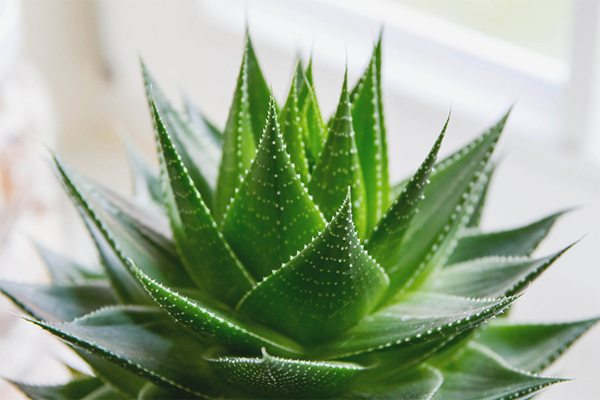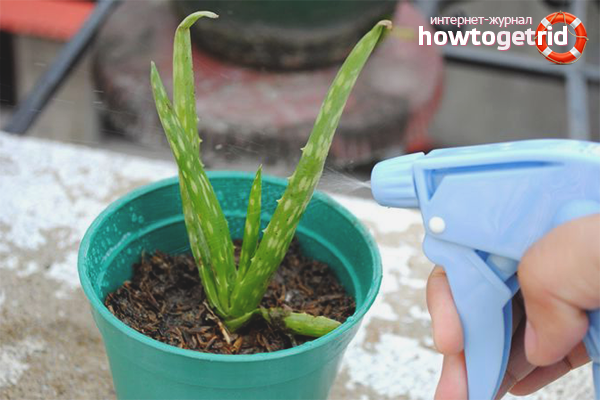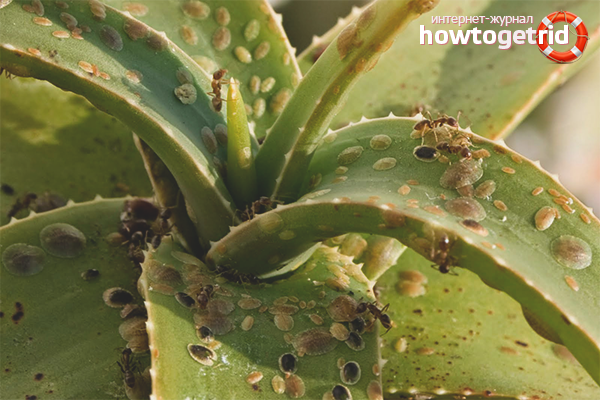The content of the article
Aloe is one of the most popular ornamental plants today. There are more than three hundred species of this flower in the world. Homeland Aloe - South Africa. Today you can hardly meet a grower, on the window sill of which a beautiful tree with thick fleshy leaves would not flare. And it is not surprising - aloe is actively used in medicine and cosmetology. Due to its antiseptic properties, aloe can cope with many problems. In addition to all this, this flower perfectly decorates the room, fits into any interior and brings something special and cozy into the image of the house.
How aloe breeds
So you decided to grow aloe at home. This plant reproduces in four main ways.
- Split trunk. Such reproduction of a flower usually occurs when it is transplanted.Aloe vera has a very powerful and spreading root system. Therefore, once a year the flower must be transplanted into more spacious pots. When a plant grows in a single pot for a long time, its trunk may split (tree-like aloe). When transplanting two trunks neatly severed and planted in different pots.
- Scions. Also, during transplantation, root processes can be found near the roots. They are not as strong and powerful as forked trunks, but they are quite suitable for breeding. Usually, root processes already have their own root systems and they can be immediately planted in new soil.
- Cuttings If the plant from which you want to grow new aloe vera does not give root processes and does not split, you can multiply it by cutting. To do this, cut the top of the plant or its large sheet. Aloe can take root in two ways. The first - lower the cut part into the water and after a week you will notice that it is covered with small roots. The second way is to leave the cut part without water, so that the cut dries out slightly. After this process is planted in the ground. Oddly enough, it is well received.
Another way to breed aloe is seeds. They are rarely used, because even without seeds, aloe vera reproduces well and is well received on any soil. If you want to grow aloe from seeds, buy them in the florist shop and grow under an ultraviolet lamp. This is a prerequisite for the emergence of shoots.
How to plant aloe
You have already found a piece of aloe that you want to plant. For the plant will need a small pot. Do not immediately buy a large-capacity pot - it is better to replace it once a year.
The bottom of the pot should be lined with drainage. It may be expanded clay stones or brick cuttings. The soil is prepared from three components - five parts of garden soil, one part of peat and two parts of sand. Ready mix for different plants can be bought in specialized stores. In the prepared soil need to plant the stalk so that the soil covered the entire aloe root.
If you are transplanting a plant from a smaller pot into a more spacious container, you need to carefully separate the ground along with the roots from the walls of the pot with a knife and transplant it to a new place.The space between the walls of the new pot and the roots is covered with soil.
How to care for aloe
Aloe is a fairly unpretentious plant that grows well even for beginner gardeners. Aloe blooms at home rarely, but sometimes it happens. Aloe flowers can be yellow, red or orange. They are quite large and unusual.
In order for a flower to grow beautiful, lush and large, you need to follow a few rules for its care.
- Location Aloe vera grows well in the shade - in winter you don’t need to think about artificial lighting. However, he feels best in the sun. Leave the aloe pot on the sunny side of the house so that it grows well. In the summer months, in hot weather, you should not leave the plant in direct sunlight for the whole day. It is better to leave it where the sun will touch it in the morning or in the evening. In the warm season, aloe can be exposed to fresh air - a balcony or loggia. This allows the plant to be saturated with oxygen and get a kind of hardening. If you notice that the leaves of aloe have become sluggish and have begun to curl, this means that the plant does not have enough sunlight.Provide a flower for sunbathing and it will come to life. And do not leave the plant in a draft - it does not like it.
- Temperature. Aloe does not react strongly to temperature drops. In winter, the thermometer should not fall below 15-10 degrees. In summer, the optimum temperature for a flower is 25 degrees. Since it is aloe from Africa, the flower can withstand very high temperatures - more than 40 degrees.
- Watering. The plant does not like a lot of moisture, so watering aloe is often not worth it. In spring and summer, you need to water the plant more often, 2-3 times a week. But in the winter, when the plant slows down its growth, it is necessary to water the flower only when the soil becomes dry. Excessive moisture can lead to rotting of the roots and the death of the plant. Watering is carried out with settled water at room temperature. Cold or hot water plant can not be watered. In the summer, when the air becomes dry, aloe needs regular spraying. You can also gently wipe its leaves with a damp cloth to wipe off any dust.
- Fertilizer. In order for a flower to grow well and blossom, it must be fed to the active phases of the year. For this spring and summer, the flower is fertilized.In the store for gardeners you can buy mineral fertilizers intended for cacti or a complex top dressing suitable for any flowers.
Diseases and pests of the plant
Like a person, aloe vera grows poorly and does not develop, if something is missing or, on the contrary, something interferes. Let's try to deal with the main problems faced by aloe.
- If the leaves have become lethargic and pale, then you water the flower too much. Reduce the amount and intensity of watering and the plant will return to normal.
- If the aloe leaves become reddish and shriveled, it means that the sun bakes too much. Do not leave the plant in direct sunlight - leave it in the shade for a while or expose only in the morning or in the evening, when the sun is not so aggressive.
- Sometimes the edges of aloe leaves turn yellow or dry. Many people think that this is a lack of moisture. But it is not. Thus, the plant responds to poor water quality, or rather, to a large amount of chlorine in it. Assert water or pass it through the filter to reanimate aloe.
- If aloe is not growing, then the soil is not fertile enough. Very often, the plant stops growing and developing if the soil is too clay, not conducting oxygen. Replant a flower to try to save it.
- If the aloe roots have rotted, then the plant is sick root rot. This is due to excessive watering. Also, the roots begin to rot, if you water the flower with cold water. In this case, the flower should be dug out and carefully separate the healthy parts of the roots from the rotted ones. Completely change the ground and plant a healthy part of the plant in the new soil. If the root has decayed completely, it remains only to cut the stem, put it in the water and hope that it will give new roots.
- Aloe has pests that cause a lot of trouble to the plant. A mealybug is a rather large insect that can be removed by hand or using tweezers. If you have noticed such an uninvited guest, treat the leaves with garlic tincture on alcohol or special insecticides. Spraying the plant with cold water will help against spider mites.
The benefits of aloe
If you have aloe in your home, it means that you have not only a beautiful flower on your windowsill, but also a first-aid kit and even a cosmetic bag. But only an adult plant that is at least three years old can benefit. Consider the most popular methods of using aloe.
- Aloe has a pronounced antibacterial effect, due to which it is used in the treatment of ENT diseases. Aloe juice is successfully buried in the nose for the treatment of rhinitis, with a diluted juice, gargle with sore throat, laryngitis and tonsillitis.
- This plant perfectly heals open wounds, pulls out pus and disinfects infected skin.
- Aloe is widely used in cosmetology. With the help of the juice of its leaves, you can clear the skin of acne, blackheads and boils. Aloe is successfully used in the fight against dandruff and seborrhea.
- This herb can provide burn therapy as a first aid. In the event of a burn, apply a cut to the affected skin area along the sheet so that the cutting area covers the wound. This will partially relieve you from pain and speed wound healing.
- Aloe is successfully used in the treatment of eye diseases. Purified and diluted aloe juice is buried in the eyes during conjunctivitis, blepharitis,keratite and clouding of the lens.
- Broth plants drink in various diseases of the digestive tract. If you drink it on an empty stomach, the plant helps to heal the ulcer, soothes the inflamed gastric mucosa during gastritis, improves the bowels.
Aloe is a useful plant in all respects. It does not require special care and any separate conditions for life. A few simple rules will help you grow on the window a beautiful decorative flower that will delight you in summer and winter.
Video: how to plant aloe














To send